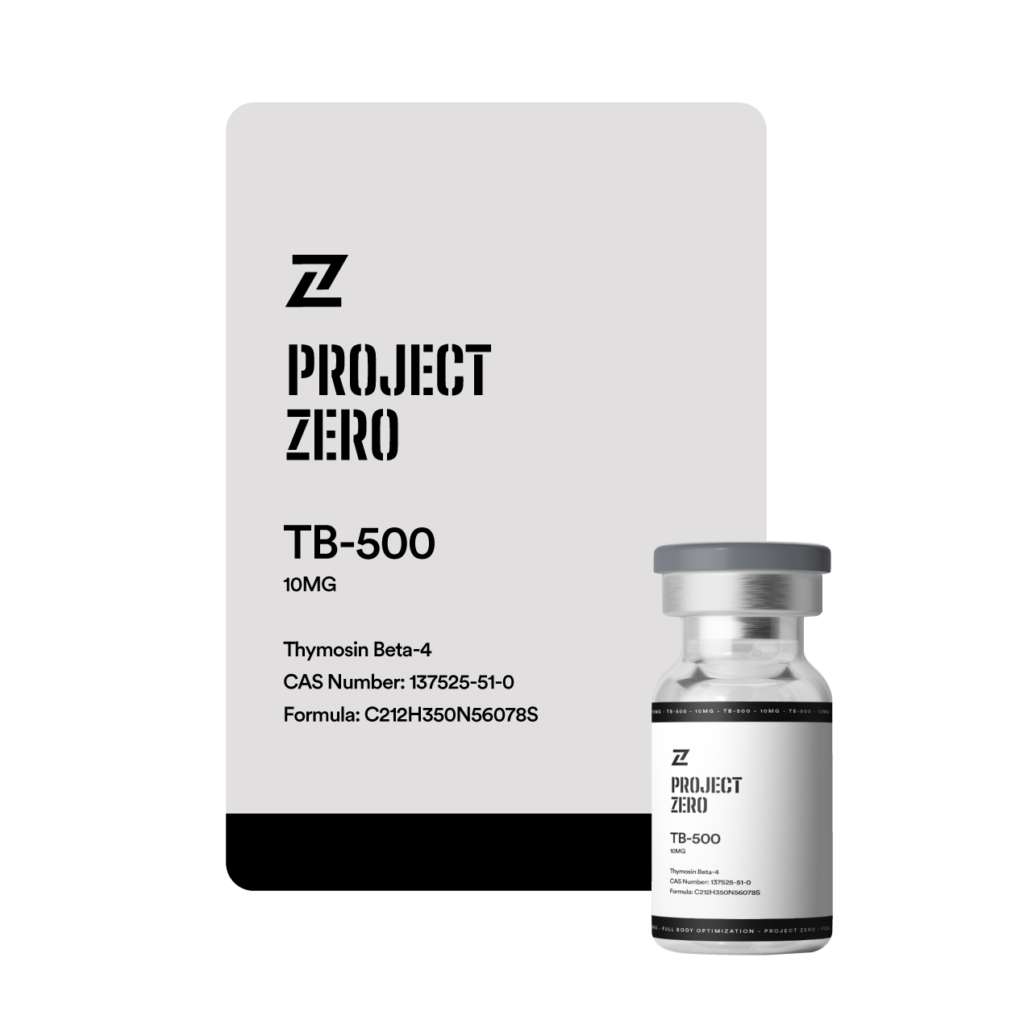TB-500:
Dosage, Benefits,
and Research Explained
TB-500 is a synthetic version of Thymosin Beta-4, a naturally occurring peptide found in nearly all tissues in the body. It plays a crucial role in wound healing, tissue repair, and inflammation reduction. Known for its potent regenerative properties, TB-500 is widely used by athletes, biohackers, and individuals recovering from injuries.
Unlike other peptides, TB-500 has a low molecular weight and high mobility, allowing it to travel long distances through the bloodstream, promoting systemic healing effects beyond just localized areas of injection.
Thymosin Beta-4
CAS Number: 137525-51-0
Formula: C212H35ON56O78S
| Purpose | Dosage | Frequency |
|---|---|---|
| Injury Recovery | 2-5 mg weekly | Once weekly |
| Inflammation/Repair | 2-5 mg weekly | Once weekly |
How It Works
TB-500 upregulates actin, a protein essential for cell migration and tissue regeneration. This allows it to:
✔ Accelerate wound healing in muscles, tendons, and ligaments
✔ Enhance recovery from injuries and surgeries
✔ Reduce inflammation and oxidative stress
✔ Promote new blood vessel growth (angiogenesis)
✔ Increase flexibility and reduce scar tissue formation
Because of its ability to promote rapid healing, TB-500 is commonly used for sports injuries, post-surgery recovery, and chronic inflammation management.
Research-Backed Benefits
1. Accelerated Wound & Injury Healing
TB-500 promotes faster recovery from muscle tears, tendon injuries, and ligament strains by boosting cellular regeneration and reducing fibrosis (scar tissue formation).
2. Anti-Inflammatory Effects
By reducing inflammatory cytokines, TB-500 helps manage chronic inflammation, arthritis, and autoimmune conditions.
3. Increased Flexibility & Mobility
Users report improved joint flexibility, less stiffness, and a greater range of motion, making it beneficial for athletes and aging individuals.
4. Tissue & Organ Protection
TB-500 has shown protective effects on the heart, lungs, and liver, reducing oxidative damage and inflammation.
5. Hair Growth & Skin Regeneration
TB-500 may stimulate hair regrowth by increasing blood flow to hair follicles and supporting skin tissue repair.
Conclusion
TB-500 is a powerful regenerative peptide known for its wound healing, inflammation reduction, and tissue repair properties. It is widely used for injury recovery, post-surgery healing, and joint mobility improvements. By promoting systemic healing and flexibility, TB-500 is a game-changer in injury rehabilitation and anti-aging medicine.
Disclaimer
This product is for research and educational purposes only. It is not FDA-approved for medical use, diagnosis, or treatment. Always consult a healthcare professional before use.
How does TB-500 compare to BPC-157?
✔ TB-500 is systemic, meaning it spreads throughout the body and promotes widespread healing.
✔ BPC-157 is localized, meaning it works directly at the injection site and is more effective for specific injuries.
🔥 For maximum healing, many users stack TB-500 + BPC-157!
How long does it take to see results?
- Minor injuries: 2-4 weeks
- Chronic injuries/inflammation: 4-8 weeks
- Post-surgery recovery: 6+ weeks
Are there any side effects?
TB-500 is well-tolerated, with minimal reported side effects. Possible mild effects include:
✔ Temporary fatigue or grogginess
✔ Mild injection site irritation
✔ Slight increase in hunger
Can TB-500 be stacked with other peptides?
TB-500 is well-tolerated, with minimal reported side effects. Possible mild effects include:
✔ Temporary fatigue or grogginess
✔ Mild injection site irritation
✔ Slight increase in hunger
Referenced Citations
- Corpas, E., et al. (1993). “Growth hormone (GH)-releasing hormone-(1-29) twice daily reverses the decreased GH and insulin-like growth factor-I levels in old men.” Journal of Clinical Endocrinology & Metabolism, 76(5), 1344-1348. [Online].
Available: https://pubmed.ncbi.nlm.nih.gov/8496328/ - Khorram, O., et al. (1997). “Effects of [norleucine27]growth hormone-releasing hormone (GHRH) (1-29)-NH2 administration on the immune system of aging men and women.” Journal of Clinical Endocrinology & Metabolism, 82(11), 3590-3596. [Online].
Available: https://pubmed.ncbi.nlm.nih.gov/9360513/ - Vittone, J., et al. (1997). “Effects of single nightly injections of growth hormone-releasing hormone (GHRH 1-29) in healthy elderly men.” Metabolism, 46(1), 89-96. [Online].
Available: https://pubmed.ncbi.nlm.nih.gov/9005976/ - Stier, H., et al. (2013). “Safety and Tolerability of the Hexadecapeptide AOD9604 in Humans.” Journal of Endocrinology and Metabolism, 3(1-2), 7-15. [Online].
Available: https://jofem.org/index.php/jofem/article/view/157/194 - Walker, R.F., et al. (1994). “Growth hormone secretion in healthy elderly men: assessment by deconvolution analysis and approximate entropy algorithm.” American Journal of Physiology, 267(1 Pt 1), E150-E157. [Online].
Available: https://pubmed.ncbi.nlm.nih.gov/8048505/ - Villalobos, C., et al. (1997). “Somatostatin and GHRH: synthesis, receptors, and intracellular signaling.” Trends in Endocrinology & Metabolism, 8(10), 390-397. [Online].
Available: https://pubmed.ncbi.nlm.nih.gov/18406829/
